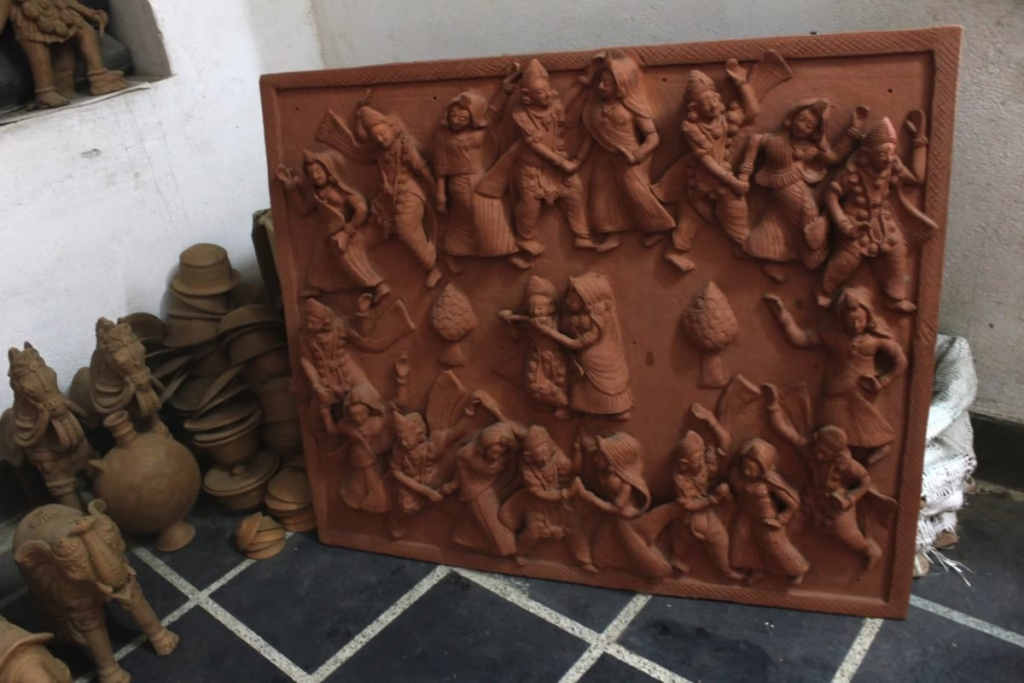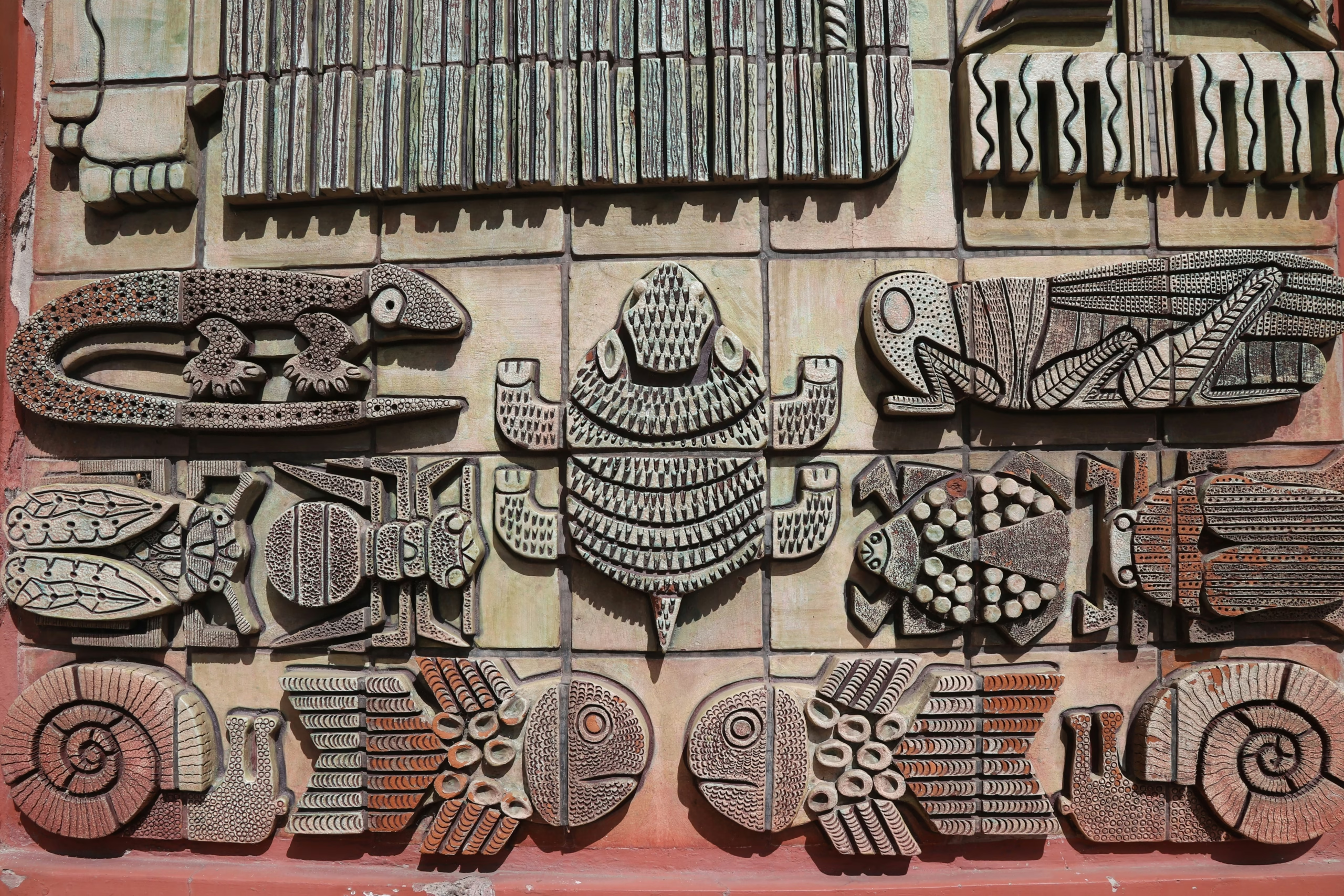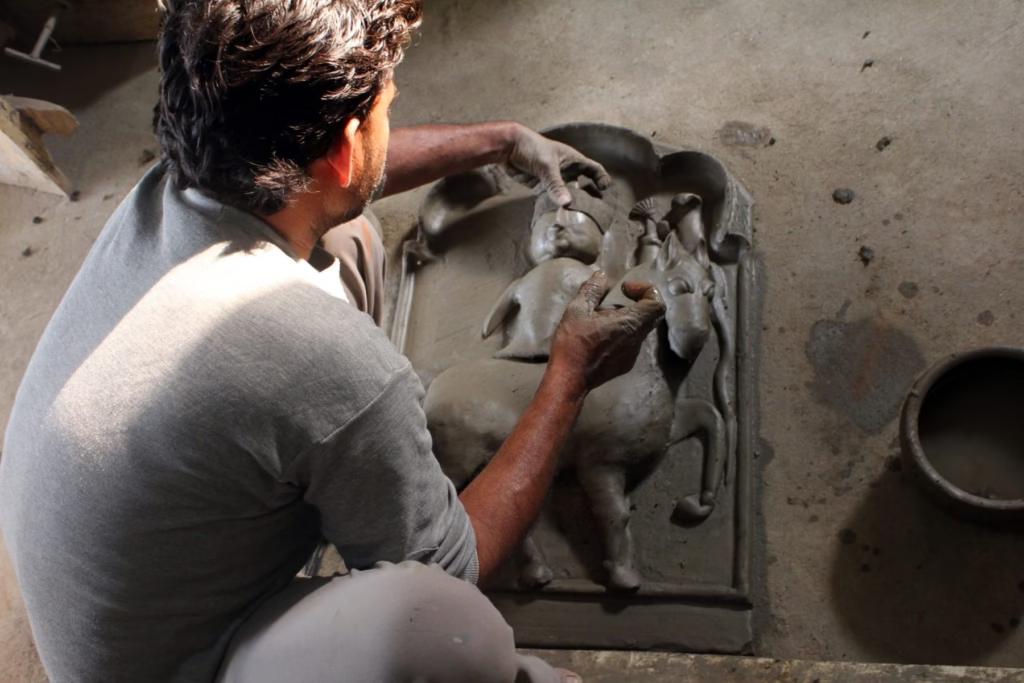Welcome to a world where mud turns into magic! Let’s talk about Molela Terracotta Plaques; beautiful clay art from a small village in Rajasthan. This art is not just pretty, it’s also holy! For years, villagers have been making these clay plaques with gods, goddesses, and folk stories. And guess what? Now, this village art is becoming popular in big cities too!
The village of Molela, near Udaipur, is home to this amazing tradition. About 70% of the families there make these plaques by hand. No machines, no potter’s wheel; just simple tools and lots of love.
And here’s something cool – designers and home decorators now use Molela art in modern homes, cafés, and hotels. In the last 5 years, the demand for this clay art has gone up by 60%. Looks like tradition has found a new best friend: modern interiors!
Get ready to fall in love with this sacred and stylish art form.
What is Molela Art?

Let’s start with a fun fact: Molela art doesn’t need a potter’s wheel! Shocking, right? While most pottery spins its way into shape, Molela terracotta plaques are handmade with love and storytelling in every inch of clay. This beautiful art form comes straight from Molela village, a tiny spot on the map near Nathdwara in Rajasthan, but its charm is making big waves far beyond the village borders.
- Origin from Molela Village Near Nathdwara, Rajasthan
Molela is a small village near Nathdwara, Rajasthan, sitting by the Banas River. This village might be tiny, but it’s big on talent! The locals here have been making these sacred clay plaques for generations. About 70% of the families in Molela are involved in this beautiful craft today. That’s a whole community shaping faith with their hands!
- Importance of Religious storytelling through Clay
Each plaque is like a mini-movie made of mud. They show gods, goddesses, animals, and village life, all in 3D! You’ll find figures like Dharamraj, Nagaraja, and folk deities beautifully crafted from clay. These artworks were mainly made for tribal pilgrims, who placed them in temples or homes to seek blessings. It’s art with a message, and some good luck too!
- A quick stat: Over 70% of Molela Households are involved in this Terracotta Craft
Did you know that over 70% of households in Molela are directly involved in this terracotta craft? That means nearly every other home you walk past in this village has artists shaping gods and stories from clay! It’s not just an art form; it’s the heartbeat of the community.
- Teaser: How Urban Designers are Now Loving this Rural Tradition
Who knew that sacred clay could look so stylish? Today, Molela art is not just for temples; it’s now trending in modern homes, cafés, offices, and even hotel lobbies. Interior designers love its raw texture and deep meaning. In fact, the demand for Molela plaques in city décor has shot up by 60% in the last 5 years. Tradition just got a trendy upgrade!
The Artistic Soul of Molela: A Living Craft

What happens when you mix mud, magic, and a whole lot of faith? You get the beautiful terracotta art of Molela. This little village in Rajasthan is home to a very special kind of clay work. The people here don’t just make pots or pans. They make flat clay plaques with gods, goddesses, and folk stories shaped into them, by hand!
This isn’t just art. It’s a tradition that’s been passed down from generation to generation. You’ll still find families in Molela sitting outside their homes, shaping soft river clay into sacred figures. And guess what? More than 70% of the households in Molela are involved in this craft. That means almost every home here is an art studio!
Let’s take a closer look at what makes this living art so special:
- Art Inspired by Deities like Dharmaraj, Nagaraja, and Local Folk Gods
The plaques often show Dharmaraj, Nagaraja, and many village gods. These aren’t random shapes; they tell stories. Each figure has a meaning, like protecting the family or bringing good luck. It’s like a comic book from the old days, only made with clay instead of colors.
- Traditional Use: Plaques Placed in Tribal Temples or Homes
People used to place these plaques in tribal temples and on home walls. They weren’t just for show. These were believed to be blessed items that could invite peace and keep away bad vibes. Who needs Wi-Fi when your wall is protected by gods?
- Why Molela is One of The Few Places in India Making Such Relief Terracotta Work
Molela is one of the very few places in India where this type of relief-style terracotta work is still done. And it’s not easy; no potter’s wheel, no big machines, just skilled hands and lots of care.
Statics: More than 3000 unique plaque designs have been created over the last few decades
Over time, artists here have created more than 3,000 different plaque designs. That’s a lot of creativity from one small village!
From Mud to Masterpiece: How Molela Terracotta Plaques Are Made

Making a Molela terracotta plaque is no quick job. It’s a step-by-step process that mixes tradition, creativity, and a good amount of muddy fun. What begins as soft clay from a riverbed ends up as a stunning piece of sacred wall art. There’s no big machine, no fancy tools; just hands, heart, and heritage.
Molela artists follow the same steps their grandparents did. That’s the beauty of it; every step is done with care, and each plaque carries a piece of Rajasthan’s culture. It’s not just about making something pretty. It’s about keeping a story alive in clay.
And guess what? These plaques are now turning heads in big cities. Designers in Mumbai, Delhi, and even New York are using Molela art to decorate homes and cafes. It’s like village tradition just got a cool city job.
So , how do these muddy miracles happen? Let’s take a look at the journey:
Step-by-Step Process:
- Soil Selection: Clay is taken from the Banas River near Molela. It’s not random soil; fine alluvial clay is chosen for its smooth texture. This is the base of the magic.
- Clay Preparation: The clay is mixed with donkey dung and wheat husk (yes, seriously!) and left to rest for a week. This makes the clay strong, smooth, and ready to shape.
- Moulding & Hand Sculpting: With no potter’s wheel, artists sculpt each piece by hand. Figures of gods, animals, and scenes are carefully crafted with simple tools, or even just fingers.
Shapes Carved by Hand (No Potter’s Wheel!)
- Drying: The shaped plaques are left under the sun for 5 to 10 days to dry naturally. The ideal drying temperature is between 25°C to 35°C. If it’s too cold or too hot, the plaque can
- Firing in Kilns: Once dried, plaques are fired in open kilns for over 8 hours, where the temperature reaches a fiery 700°C. This baking process makes the clay strong and durable. Talk about a hot makeover!
- Painting (optional): Some plaques stay natural, while others are hand-painted using earthy tones like reds, browns, and ochres. These colors are made from natural dyes, keeping the art eco-friendly.
Materials Used:
You don’t need gold or glitter to make something special; just a little clay, a lot of love, and some surprising ingredients (yes, even cow dung!). That’s exactly what makes Molela terracotta plaques so unique. This art is made using only what nature gives. No machines, no chemicals; just hands, heart, and earth.
What makes it even more special is that the materials used are local, eco-friendly, and full of cultural meaning. It’s like art straight from the lap of nature. And here’s the fun part: even though these ingredients sound simple, they all play an important role. So, let’s look at what goes into making this sacred mud magic.
- Local Clay
It starts with fine alluvial clay from the Banas River near Molela. This clay is soft, smooth, and perfect for shaping into beautiful forms. Artists say it’s like butter for their fingers!
Fact: Over 90% of plaques are made using this river clay.
This clay is rich in minerals and holds shapes well, just what you need to create stories in 3D.
- Natural Dyes
Once the plaque is fired, many artists add colors. But they don’t use synthetic paints. Instead, they use natural dyes made from stones and minerals.
About 70% of painted plaques use these natural earth tones.
Reds, browns, and ochres give the art an old-world charm and make it safe for homes, too.
- Cow Dung & Husk (As Binders and For Firing)
Now for the real rustic magic: cow dung and wheat husk! Cow dung makes the clay stronger and smoother. Wheat husk helps in the firing stage; it burns slowly and evenly in the kiln.
Each large plaque uses around 500g of this mix.
Together, these humble materials bring strength, shine, and soul to every Molela masterpiece.
So, next time you admire a Molela terracotta plaque, remember, it’s mud, tradition, and a little moo-powered magic all rolled into one.
Urban Shift: From Tribal Temples to Trendy Interiors
Once upon a time, Molela terracotta plaques lived quiet lives in tribal temples and rural homes, bringing blessings, telling sacred tales, and chilling peacefully on mud walls. But now? These humble clay creations have become total showstoppers in big city homes, designer cafés, stylish boutiques, and even fancy hotel lobbies. Talk about a glow-up!
Molela’s sacred art is no longer just spiritual; it’s become stylish. Interior designers across India are loving the raw, rustic charm of these handmade plaques. They say Molela art adds a soulful touch to modern spaces, like tradition giving a warm hug to minimalism.
- Urban Homes, Cafes, and Boutiques Using Molela as Statement Art
From Mumbai lofts to Delhi cafés, Molela plaques are turning plain walls into storytelling zones. Whether it’s a cozy home corner or a posh restaurant wall, Molela has found its spotlight.
- Architects Now Add Plaques to Courtyards and Walls
Architects have also joined the fan club. They’re embedding these plaques in walls, courtyards, entrance panels, and even balconies to mix modern design with cultural depth.
- Demand Up by 60% in 5 Years
Stat alert: In the past five years, demand for Molela art in metro cities has grown by a whopping 60%. That’s a big leap for a village craft that once stayed hidden in temple corners.
- Custom Designs: Peacocks, Trees, Dancers & More
While gods and goddesses are still popular, urban customers also love custom themes, like peacocks, dancing women, trees, birds, and even abstract shapes. Artists are happy to blend new ideas with old techniques.
The Artists Behind the Clay: Carriers of Culture
Every beautiful Molela terracotta plaque has a story, and behind that story is an artist with muddy hands and a heart full of tradition. These aren’t just any artists. They are the soul of Molela, shaping not just clay but centuries of faith, storytelling, and rural pride.
Most of these artists belong to the Kumhar community, a traditional potter caste in Rajasthan. But here’s the twist, unlike potters spinning pots on wheels, Molela artists don’t use a wheel at all! They use just their fingers, wooden tools, and years of skill passed down like family treasure.
- Mostly from the Kumhar Community in Molela Village
The Kumhars of Molela are more than potters. They are storytellers, historians, and keepers of sacred art. Each figure they mold is a scene from culture, a slice of belief, or a piece of village life.
- Passed from Generation to Generation
This isn’t something you learn from YouTube. It’s taught at home, on the floor, with grandma correcting your first clay god. From father to son, mother to daughter, this art flows like a family recipe.
Statistics: About 150+ families in Molela still make terracotta plaques today. That’s almost every lane in the village buzzing with creativity!
Famous artists:
Nathulal Soni (Padma Shri awardee) & Chotelal Kumhar, etc.
Some names shine brighter than clay. Nathulal Soni, one of the most respected artists from Molela, even won the Padma Shri for his dedication to this craft. Artists like Chotelal Kumhar have also taken Molela art to national platforms.
Challenges: Urban migration, Lack of Young Artisans
While Molela’s clay plaques are getting all fancy and popular in cities, the real makers of the magic are quietly facing some tough times. Behind the smiles and smooth clay is a world where things are changing, and not always for the better.
Let’s talk about the biggest challenge first: urban migration. Many young people from Molela are packing their bags and heading to the big cities. And hey, can you blame them? Cities come with salaries, soft couches, AC, Wi-Fi, and midnight pizza deliveries. It’s hard to convince someone to sit under the sun all day, molding clay with their hands, when a desk job in the city offers clean clothes and a monthly income.
Buying Molela Art: From Village Markets to Online Stores
So, you’ve fallen in love with Molela terracotta plaques; join the club! These sacred-yet-stylish clay artworks are no longer just sitting in tribal temples or village homes. Now, they are available for you to hang on your own walls. But where do you buy them? Do you need to ride a camel to Rajasthan? Thankfully, no. You’ve got options, and they’re pretty cool!
Traditionally, you’d find these beautiful plaques in the local markets of Molela village, just a few kilometers from Udaipur. Walking through those dusty lanes, you’ll spot artisans with clay-stained hands, carefully placing their finished works in the sun. Buying from here means you get the real deal, directly from the creators. Plus, the artists might even throw in a story or two about the gods they just sculpted!
Where to Buy:
If you can’t make it to Molela, don’t worry! You can also find these treasures at places like:
- Dilli Haat in Delhi
- Rajasthan Handicrafts Emporiums in most Indian cities
- And yes, even online, from platforms like Gaatha, Okhai, and Amazon Karigar
These sites feature verified artisan groups, so you can be sure your money is going to the right hands (the muddy, magical ones).
Price Range:
The best part? Molela art is beautiful and affordable.
- Small plaques (perfect for homes) cost around ₹300–₹800
- Large or custom plaques (with unique themes or details) can go ₹2000 and up
Totally worth it for a piece of living tradition, right?
Statistics: Export demand rose by 40% after 2020. Here’s a fun stat: After 2020, export demand for Molela art rose by 40%! With more people across the globe valuing handmade, sustainable décor, these plaques are now traveling the world faster than some of us!
Final Thought
Molela terracotta plaques are not just made of clay; they are made with love, stories, and tradition. What started in a small village in Rajasthan is now loved in big cities too. These beautiful plaques tell old stories in a new way, and they bring culture, blessings, and beauty into every home.
Even though life is changing and many young artists are moving to cities, the art of Molela is still alive, thanks to the hardworking families who keep it going. Each piece you see is shaped by hand, fired in a hot kiln, and filled with heart.
So, if you ever buy a Molela plaque, remember: you’re not just buying home décor. You are supporting an artist, saving a tradition, and bringing a little piece of India’s soul into your home.
Let’s keep this amazing art alive; one clay plaque at a time!
You may check out our Blog Page on Traditional Indian art.


Leave a Reply